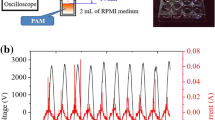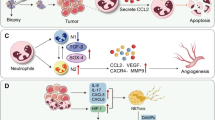Abstract
Objective
To explore a method of extracting tumor interstitial fluid (TIF) which is similar to muddy phlegm in Chinese medicine (CM), interleukin-8 (IL-8) in concentration was taken as the representative of the content of TIF, analyzed in the extracted TIF and the original tumor tissue, and examined to see whether TIF has an interfering effect on tumor recurrence.
Methods
Tumor tissue was ground, centrifuged, and filtered for intercellular substances. Tumor-bearing Kunming S180 mice were raised for 21 days and then the tumors were removed to observe the influence of intervention with TIF, normal saline (NS) and a blank control on tumor recurrence.
Results
The content of IL-8 in the filtered and unfiltered tumor tissue was not significantly different (P>0.05). Postoperative tumor recurrence in TIF intervention group was significantly higher than that in the NS intervention and control groups (60%, 12/20 vs. 20%, 4/20. vs. 15%, 3/20, χ2 =11.058, P<0.01). Tumor cells grew vigorously and infiltrated to muscular tissue in TIF intervention group. Large numbers of tumor cells were seen necrotic in the NS intervention group, and small numbers of tumor cells were seen necrotic in the blank control group.
Conclusions
TIF can be effectively extracted by the means described. It does not contain tumor cells, but its contents such as IL-8 may stimulate tumor cell growth and promote postoperative tumor recurrence, which provided preliminary experimental basis for hypothesis of “tumor-phlegm microenvironment”.
Similar content being viewed by others
References
Bohner H, Zimmer T, Hopfenmuller W, Berger G, Buhr HJ. Detection and prognosis of recurrent gastric canceris routine follow-up after gastrectomy worthwhile? Hepatogastroenterology 2000;47:1489–1494.
Hohenberger P, Gretschel S. Gastric cancer. Lancet 2003;362:305–315.
Wei P, Xu L, Sun D, Shi J, Qin Z, Lu Y. Relations between phlegm and generation and development of gastric cancer. J Tradit Chin Med (Chin) 2008;28:152–155.
Wei PK, Yu ZH, Xu L, Qin ZF, Shi J, Sun DZ. Correlation between phlegm theory of traditional Chinese medicine and tumor stroma in gastric cancer. Chin J Basic Med Tradit Chin Med (Chin) 2006;2:309–312.
Fujimoto J. Second primary malignancy after surgical adjuvant therapy for gastric cancer. Gan To Kagaku Ryoho 1999;26:2000–2014.
Tsukuma H, Tanaka H, Koyama Y, Kinoshita N, Koyama H, Furukawa H. Descriptive and analytical epidemiology of second primaries in Osaka, Japan. Gan To Kagaku Ryoho 1999;26:1980–1987.
Hu J, Chen Z, Zhang B. System evaluation of postoperative chemotherapy of gastric tumor. Chin J Evid-Based Med (Chin) 2003; 3:4–9.
Silltti SW, Paku S. Autocrine motility factor and extracellular matrix-II degradation or remodeling of ubstratum componenets directs the motile response of tumor cells. Int J Cancer 1998;76:129–134.
Xie K. Interleukin-8 and human cancer biology. Cytokine Growth Factor Rev 2001;12:375–391.
Vicari AP, Caux C. Chemokines in cancer. Cytokine Growth Factor Rev 2002;13:143–154.
Strieter RM, Polverini PJ, Kunkel SL, Arenberg DA, Burdick MD, Kasper J, et al. The functional role of the ELR motif in CXC chemokine-mediated angiogenesis. J Biol Chem 1995;270:27348–27357.
Bizzarri C, Beccari AR, Bertini R, Cavicchia MR, Giorgini S, Allegretti M. ELR+ CXC chemokines and their receptors (CXC chemokine receptor 1 and CXC chemokine receptor 2) as new therapeutic targets. Pharmacol Ther 2006;112:139–149.
Moore BB, Arenberg DA, Addison CL, Keane MP, Strieter RM. Tumor angiogenesis is regulated by CXC chemokines. J Lab Clin Med1998;132:97–103.
Strieter RM, Belperio JA, Phillips RJ, Keane MP. CXC chemokines in angiogenesis of cancer. Semin Cancer Biol 2004;14:195–200.
Kitadai Y, Takahashi Y, Haruma K, Naka K, Sumii K, Yokozaki H, et al. Transfection of interleukin-8 increases angiogenesis and tumorigenesis of human gastric carcinoma cells in nude mice. Br J Cancer 1999;81:647–653.
Kitadai Y, Haruma K, Sumii K, Yamamoto S, Ue T, Yokozaki H, et al. Expression of interleukin-8 correlates with vascularity in human gastric carcinomas. Am J Pathol 1998;152:93–100.
Kitadai Y, Haruma K, Mukaida N, Ohmoto Y, Matsutani N, Yasui W, et al. Regulation of disease-progression genes in human gastric carcinoma cells by interleukin 8. Clin Cancer Res 2000;6:2735–2740.
Miyamoto M, Shimizu Y, Okada K, Kashii Y, Higuchi K, Watanabe A. Effect of interleukin-8 on production of tumor-associated substances and autocrine growth of human liver and pancreatic cancer cells. Cancer Immunol Immunother 1998;47:47–57.
Ueda T, Shimada E, Urakawa T. Serum levels of cytokines in patients with colorectal cancer: possible involvement of interleukin-6 and interleukin-8 in hematogenous metastasis. J Gastroenterol 1994;29:423–429
Li A, Dubey S, Varney ML, Dave BJ, Singh RK. IL-4 directly enhanced endothelial cell survival, proliferation, and matrix metalloproteinases production and regulated angiogenesis. J Immunol 2003;170:3369–3376.
Mian BM, Dinney CP, Bermejo CE, Sweeney P, Tellez C, Yang XD, et al. Fully human anti-interleukin 8 antibody inhibits tumor growth in orthotopic bladder cancer xenografts via down-regulation of matrix metalloproteases and nuclear factor-kappaB. Clin Cancer Res 2003;9:3167–3175.
Smith DR, Polverini PJ, Kunkel SL, Orringer MB, Whyte RI, Burdick MD, et al. Inhibition of IL-8 attennuate angiogenesis in bronchogenic carcinoma. J Exp Med 1994;179:1409–1415.
Arenberg DA, Kunkel SL, Polverini PJ, Glass M, Burdick MD, Strieter RM. Inhibition of reduces tumorigenesis of human non-small cell lung cancer in SCID mice. J Clin Invest 1996;97:2792–2802.
Miyamoto M, Shimizu Y, Okada K, Kashii Y, Higuchi K, Watanabe A. Effect of interleukin-8 on production of tumor-associated substances and autocrine growth of human liver and pancreatic cancer cells. Cancer Immunol Immunother 1998;47:47–57.
Author information
Authors and Affiliations
Corresponding author
Additional information
Supported by National Natural Science Foundation (Major Research Project, No. 90709044) and Shanghai Changzheng Hospital “Three Major, Three Merit” Project Fund
Rights and permissions
About this article
Cite this article
Sun, Dz., Ju, Dw., He, J. et al. Tumor interstitial fluid and postoperative recurrence of tumors: An experimental study for verifying hypothesis of “tumor-phlegm microenvironment”. Chin. J. Integr. Med. 16, 435–441 (2010). https://doi.org/10.1007/s11655-010-0537-6
Received:
Published:
Issue Date:
DOI: https://doi.org/10.1007/s11655-010-0537-6




